Americans consume 17 teaspoons of added sugars a day on average (more than one-third cup). That’s not to say we scoop that much into our coffee or tea. Sugar, in one form or another, is added to a huge variety of processed foods, from sweet drinks to cakes, cookies, candy, ice cream, and even breads, yogurt, and seemingly savory condiments and sauces such as ketchup and tomato sauce. Sugars and high added-sugar foods are not healthful choices, and switching sweeteners (say, from high fructose corn syrup to raw cane sugar) is not the answer.
What is Sugar?: When people say “sugar,” they are generally thinking of the white crystals one would find in a sugar bowl, a product typically refined from sugar cane or sugar beets. Technically, the word “sugar” has a different meaning: a sweet-tasting, soluble carbohydrate. There are three “simple” sugars (monosaccharides) in nature, glucose, fructose, and galactose. Every caloric sweetener in the natural world is formed from some combination of these three building blocks (most often glucose and fructose). Simple sugars are treated the same by our bodies whether we ingest them as sucrose (like table sugar) or as high fructose corn syrup. “There is no evidence of any difference in health impact between the major sugars in the U.S. food supply,” says Dariush Mozaffarian, MD, DrPH, dean of Tufts’ Friedman School of Nutrition Science and Policy and editor-in-chief of Tufts Health & Nutrition Letter. “Refined sugars like cane sugar, beet sugar, and high fructose corn syrup are all metabolically equivalent. Whether or not honey or maple syrup have different health effects needs more study.”
Fruits and vegetables have intrinsic sugars naturally contained within their cell walls, along with nourishing vitamins, minerals, and phytochemicals. They also have fiber that slows the release of sugars into the bloodstream and tends to limit how much one can consume at one sitting. “The health effects of sugar depend more on the dose and speed of ingestion and less on the source and type,” says Mozaffarian, “Our bodies evolved to metabolize small amounts of slowly digested sugars, such as those in a piece of fruit. When we consume added sugars, we are often getting a high dose of rapidly digested refined sugar.” This is the case even for so-called “natural” sugars. “There tends to be a misconception that if the sugar is isolated from a ‘natural’ source it does not count,” says Alice H. Lichtenstein, DSc, senior scientist at Tufts’ Human Nutrition Research Center on Aging and executive editor of Tufts Health & Nutrition Letter. “That simply is not the case. Added sugar is added sugar, even if it comes in the form of concentrated organic fruit juice. There is no getting around that fact.”
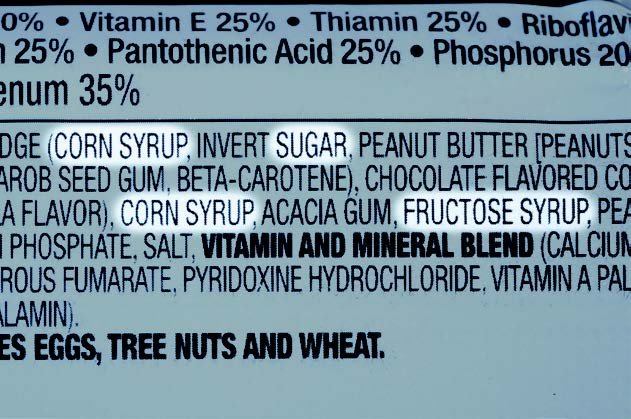
SUGAR BY ANY OTHER NAME …
Added sugars appear on ingredient lists by many names, but the body metabolizes them all in essentially the same way. On Nutrition Facts label ingredient lists, added sugars include the following:
- any ingredient with the word “sugar,” such as white granulated sugar, coconut sugar, brown sugar, beet sugar, raw sugar, or sugar cane juice
- any ingredient with the word “nectar,” such as agave nectar, peach nectar, or fruit nectar
- any ingredient with the word “syrup,” such as corn syrup, high fructose corn syrup, carob syrup, maple syrup, brown rice syrup, or malt syrup
- any ingredient containing a word ending in “-ose,” including sucrose, dextrose, glucose, fructose, maltose, lactose, galactose, saccharose, and mannose
- cane juice/evaporated cane juice/cane juice crystals
- caramel
- corn sweetener/evaporated corn sweetener
- fruit juice/fruit juice concentrate
- honey
- molasses
- muscovado
- panela (raspadora)
- sweet sorghum
- treacle
Health Impact of Added Sugars: Studies indicate that added sugars are associated with a number of adverse health concerns. “Natural sugars in fruits, vegetables, dairy, and grains are not associated with negative health outcomes,” says Lichtenstein, “but sugars that are removed from these natural sources, concentrated, and added to beverages and foods in processing are.” Sugary drinks and foods contribute directly to dental caries (cavities), and the caloric nature of many sweet treats may lead to weight gain. Being overweight or obese is, in itself, a risk factor for a number of chronic health conditions, including cardiovascular disease, type 2 diabetes and some cancers, but intake of added sugars may impact health even when weight is in the so-called “normal” range. “There is strong evidence that added sugar intake is a risk factor for type 2 diabetes,” says Lichtenstein. Strong evidence also indicates higher intake of added sugars is associated with increased cardiovascular disease risk in children and moderate evidence indicates an association with increased risk of high blood pressure, stroke, and coronary heart disease in adults. In a 2014 study in JAMA Internal Medicine, people who consumed more added sugars had a much higher risk of death from cardiovascular disease (CVD). Subjects who consumed ten percent to 25 percent of their calories from added sugars were 30 percent more likely to die from CVD than those for whom added sugars contributed less than ten percent of calories.
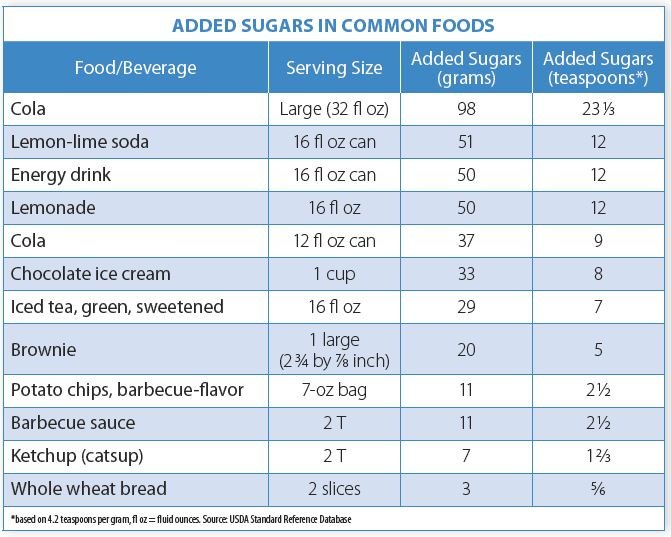
The Whole Package: High intake of added sugars is also associated with poorer diet quality. This means that people who eat a lot of foods with added sugars could be missing out on important, necessary, and health-promoting nutrients. Data indicate that it is not just the added sugars themselves (or the calories they add to our diets) that lead to health problems, it is also what we are not eating when we eat sweets and treats. A Finnish study published in the Journal of Nutrition Science in 2017 found that high added sugar intake (from foods like sugar-sweetened beverages, sugars and syrups, sweet bakery products, chocolate, and other sweets) was associated with low intake of fiber, lower fruit and vegetable consumption, and higher wheat consumption (likely from refined wheat products, rather than whole wheat). Those who consumed the most naturally occurring sugar had higher intake of fiber and fruits and vegetables (and they were also more likely to be physically active and less likely to smoke). “These findings reinforce the importance of evaluating a whole diet and not just individual components,” says Lichtenstein. “What we don’t eat can be as important as what we do eat.”
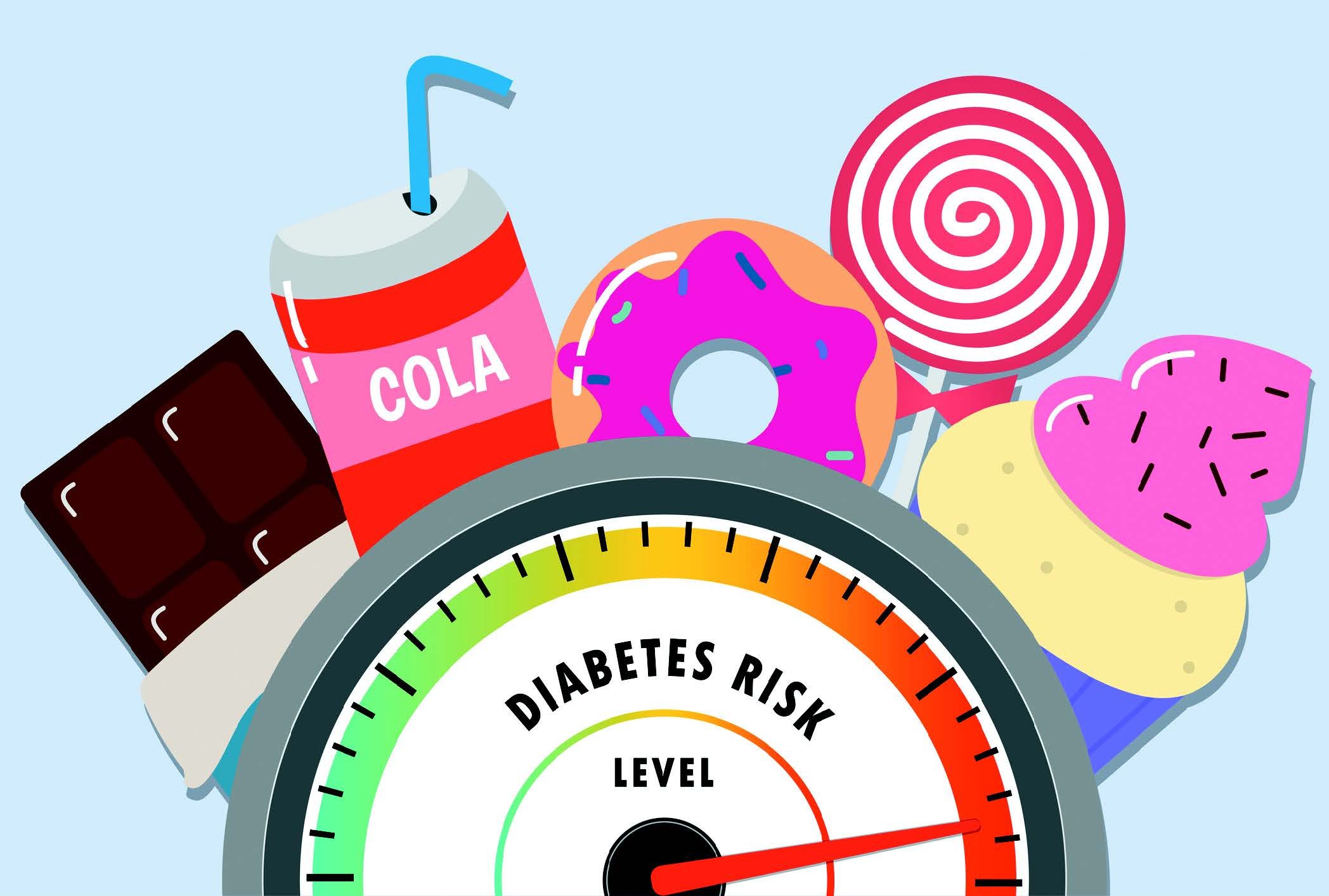
Recommendations: If we consume too much added sugar, it is difficult to meet our nutrient needs without exceeding our calorie needs. For this reason, the Dietary Guidelines for Americans (DGA) recommend limiting calories from added sugars to less than 10 percent of total daily calorie intake. For someone consuming a 2,000-calorie diet, this would mean less than about 12 teaspoons (50 grams) of added sugars a day. People who require less calories should aim for even lower added sugar intake. “Keep in mind this is a maximum, not something to aim for,” says Lichtenstein.
According to the USDA’s analysis of the most recent national survey data, only 44 percent of adults and 33 percent of children kept their added sugar intake below the DGA recommended maximum ten percent of calories in 2013-2014. On average, those who reported eating a diet in which added sugars exceeded this guideline consumed over 25 teaspoons a day.
Given the evidence associating higher intake of added sugars with heart disease, the American Heart Association (AHA) has issued recommendations that are more stringent than the DGA recommendations. The AHA suggests women and children get no more than 6 teaspoons (around 25 grams) of added sugars per day, and men no more than 9 teaspoons (around 38 grams) per day.
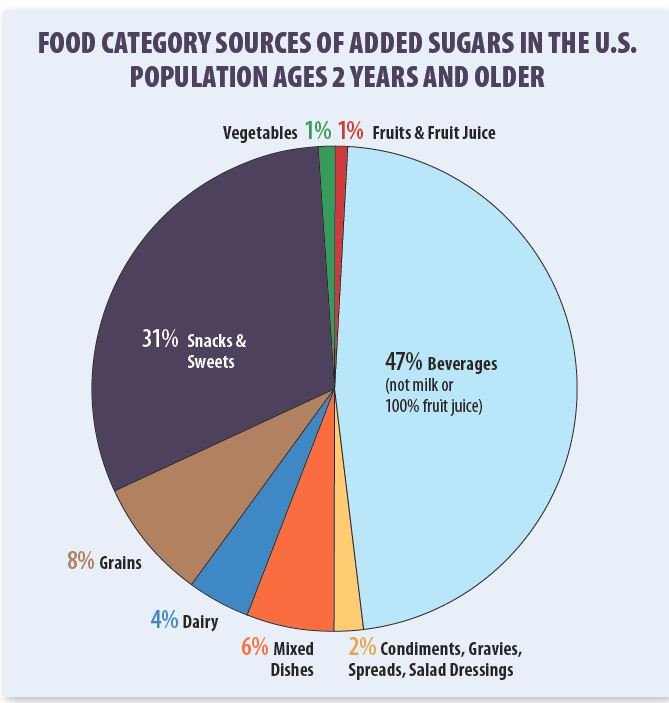
Sources of Added Sugars: Over 30 percent of added sugars in the American diet come from snacks and sweets (and ready-to-eat cereals are a significant contributor, especially in children) but nearly half of all added sugars in the American diet come from beverages. These include soft drinks (soda/pop), but also sweetened tea and coffee drinks, sports and energy drinks, and fruit drinks (which by definition contain added sugars). The DGA does not include sugars found naturally in 100 percent fruit juice in this category, although these beverages, too, are associated with weight gain. The World Health Organization includes the “free sugars” in 100 percent fruit juice in their recommendation to limit sugar intake.
According to a 2018 analysis published in the journal Nutrients, soft drinks were the main sugar-sweetened beverages (SSB) for adolescents, teens, and adults, but sweetened fruit drinks were the key contributor for children. Sports and energy drinks were increasingly prevalent in the nine and up age groups, but especially for nine- to 18-year-olds. Research has linked high intake of SSBs with poor dental health, weight gain, type 2 diabetes, heart disease, and metabolic syndrome (a cluster of symptoms associated with increased risk for cardiovascular disease and type 2 diabetes).

In response to rising concerns about the negative health effects of diets high in added sugars, the FDA has made “added sugars” a separate category on Nutrition Facts labels. This change should make it easier for consumers to monitor their intake of added sugars in particular.
The American Medical Association has called for further measures to protect the public’s health, including front-of-package warning labels for foods high in added sugars and an FDA limit to the amount of sugar that can be added to products that claim to have health or nutritional benefits. With or without these policy changes, we, as individuals, are the only ones who can choose to find a balance between the sweetness of our diets and the sweet possibility of a long, healthy life.
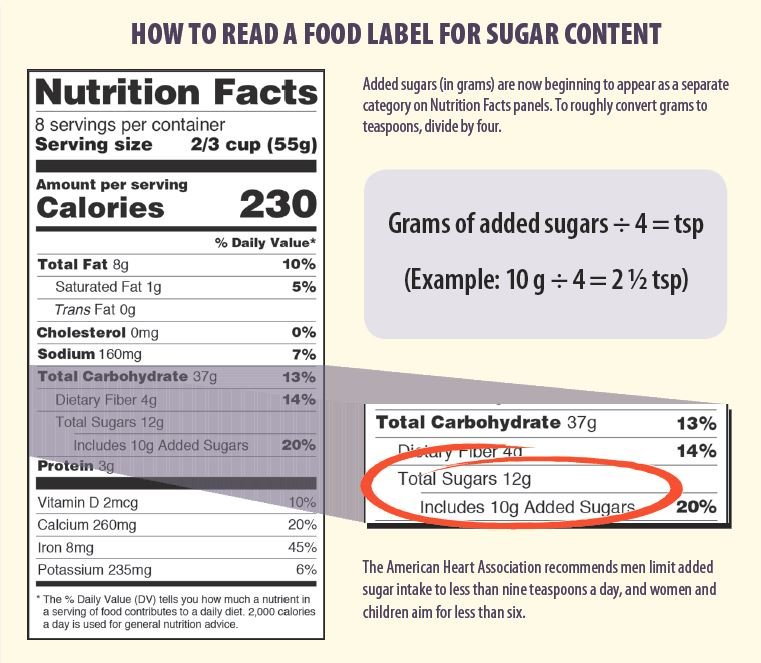
All added sugars are associated with negative health effects. Try these tips to cut back:
-Cut back on all forms of added sugars, don’t just switch from foods with high fructose corn syrup to those with added apple juice concentrate, for example.
-Make water your beverage of choice (milk and unsweetened coffee, tea, and herbal teas are also good choices)
-Gradually cut back on any sugar added to coffee and tea (and watch out for the excessive sugars often added to commercially-prepared coffee and tea drinks)
-Make sweets and desserts a treat not a daily event
-Check Nutrition Facts labels for added sugars (dividing the grams listed by four will give an approximate number of teaspoons)

























Could you comment on the value/risks of using Stevia, Eythritol and Monkey Fruit as additives for sweeting?
Thank you, I am going to read more throughly on the labels.
Like many people 80 years, and above, cane sugar was a staple during our childhood years. And, as it is with many of those people, I have paid heed to admonitions regarding the intake of such, have just about eliminated baked goods, cakes, pies, cinnamon rolls, etc. years ago. I don’t really miss them. But, one drink I cannot tolerate, and that is unsweetened coffee. I have used stevia in my coffee for years with no ill effects. Being a Vermonter it was a deep upset to give up maple syrup, but, I have done it! Along with that I gave up pan cakes, waffles, French toast as well. MY hope is that people will pay attention to what you have spelled out in this article, and curb their intakes of certain forms of sugar. Manufacturers of junk foods had better change their course in what they put onto the market for people to consume as many more stop buying what they offer. Also dismaying is seeing all the salty “goodies” on the racks at convenience stores when I take trips, and make rest stops. It is so difficult to find nuts which have not been salted, dehydrated fruits which have not been sugared, sandwiches made with whole grain bread rather than with white bread, on, and on. Perhaps what you, and other medical concerns keep pushing will have an impact to get those putting up snack foods to put out more packets of nutritious, unsugared foods. I do appreciate the researching you do as I enjoy living, and want to live beyond my 88 years.
Dana, first good for you. I applaud your ability to change for the better. And yes it is ashamed the food industry puts profits above good food.
I can’t understand with the post WWll baby boomers now in their 60s and the amount of these folks who now have diabetes at some degree, why food companies don’t produce more products that are sugar free or, at least, low in sugar. They are missing sales to a huge group of people who are looking for such products.
Thank you CSPI for all of the hard work you do to keep our food not only safe, but nutritious!! You are truly a fantastic organization and the only one I contribute to every year 😍
At last, a clear and simple method to track sugar taken through foods. A simple division of grams by four equaling a teaspoon and then ensuring intake is less than nine per day for men.
Greatly appreciated method to follow for a better life. Personally, I lowered the number of teaspoons by (at least) one.
Great Information Thanks
Good article! But what about Stevia? How does it affect the body and is it as unhealthful of any of the other sugars natural or not?
So well written and clear ! Thank you for helping me help my clients in my nutrition practice !
And what about all the sugar substitutes like the little pink and blue packets found on so many restaurant tables? Like Equal, Splenda, etc.?
I used to be one of the worst culprits for sweet additives. When I was diagnosed with metastatic prostate cancer, severe hypertriglyceridemia, HTN, I had mainstream care but a very poor prognosis. All were resistitant to the best care, which I continued, but I became a very conscientious vegan, my wife and I making everything from whole sources, supplementing B12 and D3 only. No added sugar and no added fat. First my desire for salt and sweet decreased. I started making my own almond milk very concentrated with no additives, granola using the almond pulp and including oatmeal, walnuts and sliced almonds, making my own oatmeal from whole oats, and adding banana, strawberries, and blueberries. Sweet enough. Red and yellow bell peppers sweeten stir fry, and sweet potatoes sweeten any meal. We often have the stir fry over sweet potatoes. We do not cook with salt and do not put it on our meals and within a month, the craving for salt disappeared. 21 years later, I am alive and well vastly improved with diet and conventional medical treatment. As a MD myself, I just wished that we learned about nutrition in medical training. We need to focus on wellness and prevention rather than a disease oriented system of health management. The Tufts Nutrition Letter is very helpful. Thank you.
You may find Dr. Robert Lustigs’ latest book ‘Metabolical’ fascinating.
He does mention the lack of nutritional training in medical school and the forces
contributing to that lack. Very good read, IMHO.
Congratulations on saving your own life!
Jerilyn Downing
San Francisco
Robert Haile – I literally have never posted a “comment” anywhere until now. I was so inspired by your post. Thank you for sharing. All great tips and testimonials!
May I ask for your recipe for granola? I am especially intrigued by the use of almond pulp (from making almond milk – which, by the way is SO easy, more people should try it!). Thank you, again, for sharing!
And, Tufts – great topic. Thank you for posting.
It is not necessary to give up pancakes, French toast, etc. if one makes the bread, pancakes, etc. without any added sugar, and one uses whole wheat flour. Skip the syrup but pile on the fresh fruit and optional yoghurt.
yes! I enjoyed whole wheat pancakes with chia gel to replace half the oil. Topped with peaches warmed and plain fat free Greek yogurt!
Dear Alice and staff,
Thank you SO much for the BEST, most comprehensive and clear review of added sugars ever!!!
I wish I’d had it when trying to navigate the carbo confusion expressed by my dental students and faculty colleagues. At least today’s students and faculty will be able to benefit from it. This is a very important article, and is already having a beneficial impact-as shown by the comments before mine.
So, thank you again for your thoughtful and reader-friendly presentation of this important topic.
Carole Palmer, Professor Emerita
If added sugar is used as a guide to indicate foods with low nutritional value I agree. However I don’t find it believe that the body knows where the sugar comes from. Excess sugar intake is excess sugar intake.
More research on the effects of carbohydrates as a whole and their effect on obesity etc is needed.
I!ve tried avoiding sugar since I was 12, after reading the book “Sugar Blues.” I also don’t use artificial sweeteners. I 62 and healthy!
I am disappointed in the grocery stores that sell very few teas that are unsweetened. Especially unsweetened green tea. The shelves are loaded with sweetened and extra sweetened teas.